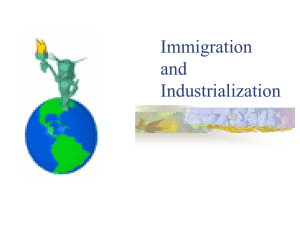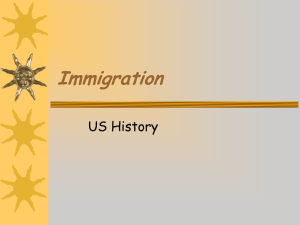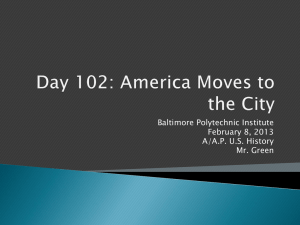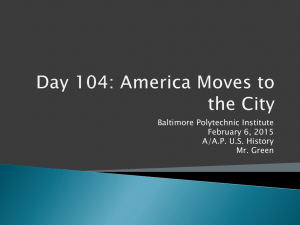Chapter 18 PowerPoint
advertisement
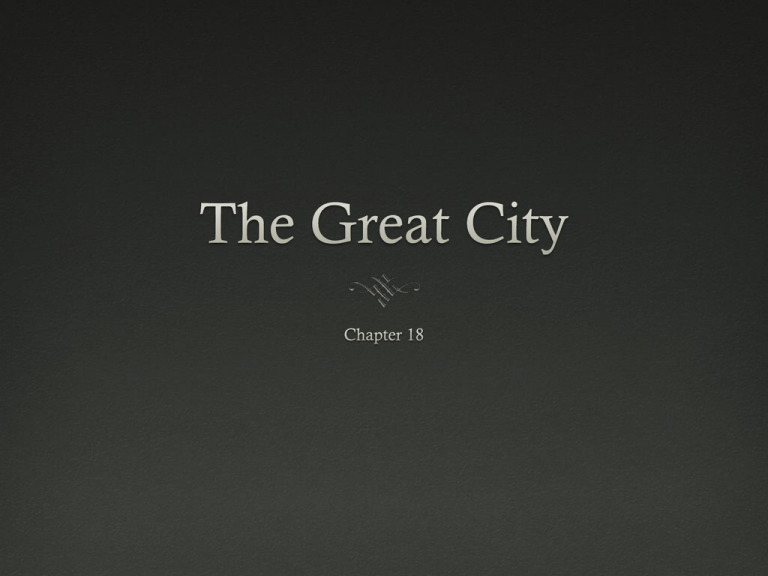
Chicago Poem Excerpts 1. They tell me you are wicked and I believe them, for I have seen your painted women under the gas lamps luring the farm boys. 2. And they tell me you are crooked, The Urbanization of America Migration from the Countryside to Urban Centers dominated American life This was the case all over the world as it became more industrialized The Lure of the City Urban population increased by 7 times from 1863-1913 1920—most American’s lived in urban areas What is an urban area?— 2,500 people or more 1860 New York City Chicago 1890 1 million 3 million people people 100,000 people 1 million people Urban Families Experienced High infant mortality rates Declining fertility High death rate from disease Harsh living conditions SO????? Why did people live in cities? Causes of Urban Growth Immigration—people from other countries coming to the U.S. and urban centers National Migration—Americans moving to urban centers Opportunities for African Americans Opportunities for Woman More readily available work Excitement of living in a city National Migrations Geographic Mobility—people had the ability to move quickly, safely and cheaply Rural Farm life was limited for woman so they moved to cities How was rural life limited for women? Southern Blacks moved to cities… Because of bigotry and racist segregation and violence in the south There were jobs up north—Although factory jobs were rare (most African Americans worked as servants in cities: cooks, janitors, general labor, etc.) Immigrants 1860-1920—28 Million immigrants came to the U.S. Most from Europe (West Coast had Asian and Mexican Immigrants) 1880—Italians, Greeks, Russian Jews, and Slavs 1890—half of all Immigrants came from South Eastern European Countries Early Immigrants were educated and had modest wealth That changed…why? The Ethnic City 1890—87% of Chicago were foreign born, 80% of New York, 84% of Milwaukee and Detroit New York had more Irish than Dublin and more Germans than Hamburg Cities were extremely racially and culturally diverse This was both strength and weakness of cities Immigrant Ghettos Ghetto—a section of a city, especially a thickly populated slum area, inhabited predominantly by members of an ethnic or other minority group, often as a result of social or economic restrictions, pressures, or hardships. Brought the Old World with them to the New World Offered familiarity and belonging to immigrants Same food, culture, way of life, no language barriers Jews and Germans advanced economically faster Why? Assimilation Assimilation—the act of becoming a part of something Most immigrants were young 15-45 Wanted to be “True Americans”—Americanization Encouraged by native born Americans Supported by churches and public education Changing Gender Roles America allowed immigrant woman more freedom Arranged marriages were not popular in the U.S. It was acceptable for women work outside the home More acceptable for women to be on their own. Exclusion The counter attack to assimilation/Americanization Nativism—native born American prejudice against foreigners Immigrants were blamed for the “ills of society” Why? Was this prejudice blind or was it based on who was coming to the U.S.? Laws tried to curb immigration but failed Immigration fueled economic growth as a read and cheap source of labor American Protective Association Founded by Henry Bowers in 1887 Stood against Catholic Immigrants Had over 500,000 members Immigration Restriction League Another national organization that stood for strict restriction on immigration Believed immigrants should be “screened” through literacy tests separating the “desirables” from the “undesirables” The Urban Landscape Cities stood in contrast: the poor were VERY poor, the rich were VERY rich Small middle class Cities struggled with how to keep the poor and wealthy separated The Creation of Public Spaces 1850’s—cities started to be “planned” Urban Parks Antidote to urban crowding and congestion Fredrick Law Olmstead and Calvert Vaux— architects of New York’s Central Park Believed in “Natural Spaces” Central Park Central Park Central Park Public Buildings City Planners, architects, wealthy people, and government officials started advocating public buildings Libraries, museums, galleries, concert halls, theaters, hospitals, etc. Wealthy citizens became philanthropic patrons who donated money for public buildings This came with the immortality of having one’s name and recognition assigned to a building: Carnegie Hall Housing the Rich Housing was an issue in Cities—the rich wanted to be away from the poor, the poor couldn’t afford to life far from where they worked, etc. Growth of Suburbs—modeled after “countryside” Why? How do the suburbs look like the countryside? The rich owned houses and buildings, the poor had to rent Housing the Poor The Poor could not afford to own so they rented High demand for scarce space gave a lot of power to landowners Manhattan Population Density in 1894 143 people per acre of land average (304 sq ft per person) 700 people per acre in the slums (64 sq ft per person) Tenements Multi-family dwellings—usually apartment buildings Located in the slums At first tenements were a great improvement for poor people instead of literal shacks Many were windowless rooms Little to no plumbing Privies (toilets) in the basement Jacob Riis Author and photographer who documents tenement living Wrote “How the Other Half Lives” Sensationalized writing that exploited the plight of the poor. Tenement Apartment Tenement Apartment Riis’s Most Famous Photo City Block Urban Transportation Paved streets opened congestion and allow for quicker, safer travel within cities Paved Roads Most were paved with wooden blocks—where we get the term “block” from, meaning a section of a city Later brick, stone and asphalt Urban Transportation Street Cars Horse drawn cars that ran on tracks were the first public forms of mass transportation Boston, New York, Chicago, Washington DC, Philadelphia Urban Transportation New York City 1887 First Elevated Railway Steam powered Urban Transportation 1887 Boston First American Subway (not the disgusting sandwich shop…shame on you for eating that…YUCK!) Urban Transportation 1880’s New York Brooklyn Bridge Opened the Island of Manhattan to the other burrows of New York Engineering Marvel The Skyscraper Cast iron, steel beams, and elevators allowed for taller buildings (over 5 floors) 1890’s skyscrapers started to be built (10 or more floors) Why is this important for cities? Strains of Urban Life Urban Life was hard and dangerous due to Crime Fire Disease Poverty pollution Human Waste Problems Early Efforts at urban sewage disposal frequently Used open ditches to remove waste Helped the spread of disease Polluted the cities fresh water supply Failed to provide clean conditions The Urban Political Machines Urban Political Machines helped newly arrived immigrants adjust to American life In return these “Bosses” (elected officials) could count on support from voting immigrants Political bosses were the primary source of welfare for the urban poor. Goals of the Political Machines 1. 2. 3. 4. Make money for political bosses (officials) Provide services to immigrants Create city jobs for machine supporters Find jobs for the unemployed The Rise of Mass Consumption Mass Consumption—the production and sale of inexpensive everyday items that came about at the end of the 1800’s Growth of middle class gave rise to mass consumption Middle class people could afford to buy lots of things in quantity The most popular mass consumption items were the making and marketing of ready-made clothes Middle class women were most effected by mass consumption—why? Patterns of Income and Consumption Society changed, as did the market place, with the growth of the middle class and their growing income This lead to The emergence of Department Stores The making of large amounts of affordable products The creation of marketing and advertisement The rise of chain stores Department Stores Giant “have everything” destination stores Offered a wide range of diverse products—bras and guns Created a shopping atmosphere of excitement Made shopping an activity and glamorous Large quantities of goods lowered prices Hudsons Inside Hudson’s Detroit Hudson’s Now Popular Culture in the late 1800’s Popular forms of entertainment Vaudeville Musical comedy Movies—silent movies Professional baseball Theatre Movies became the first truly universal mass-entertainment medium which reached all over the country and all levels of society Why? Yellow Journalism A popular style of journalism that was popular in the early 1900’s that used a sensational, lurid style of reporting. Art in the early 1900’s Authors like Stephen Crane and Theodore Dreiser wrote very popular novels about the mistreatment of the poor in urban industrial society. Artists began painting realistic scenes of ordinary life Education in the Early 1900’s Industrialization created a need for specialized skills and scientific knowledge, the educational system answered these needs through 1. 2. 3. 4. Growth of women’s colleges Rise in free public education An increase in the number of colleges and universities Growth of universities in western states Women in the early 1900’s Graduates of Women’s colleges formed the first “intellectual” women’s group who… 1. 2. 3. 4. 5. Worked together for reform (divorce laws, suffrage, etc.) Frequently married much later in life Were career based instead of family based Became faculty in women’s colleges Started by philanthropic institutions “Civilizing” the Indians Programs were created to “civilize” Indians through white-run, reservation schools They failed in large part to… A lack of long term commitment and funds The teaching and administration was poor The ideas of transforming culture was unpopular with the Indians White educators showed hostilities towards tribal culture Review Question 1 Because of rapid growth in the latter nineteenth century, American cities: a) protected traditional social and cultural values. b)provided services and facilities inadequate to demands. C) witnessed the flight of factories and corporate offices to newer, less crowded locations. D) supported efficient and honest governments. Review Question 2 An important population trend that occurred in the United States from 1860 to 1910 was: a) a gradual decline of the rural population. B) the mass movement of urban population of all classes from city centers to suburbs. C) a population shift from the North to the South. D) a faster rate of growth for the cities than for the general population. Review Question 3 The movement of blacks from the rural South to industrial cities began during the latter nineteenth century because of : a)poverty and oppression in the South. B)prospective professional opportunities in the cities. C)the abundance of factory jobs in the North for blacks. D) the lack of racial discrimination in the North. Review Question 4 The new immigrants of the latter nineteenth century settled primarily in Eastern industrial cities because they: a)lacked the capital to buy land and begin farming in the West. B)found immediate employment as unskilled factory workers. C) found refuge and camaraderie among fellow nationals there. D) All of the above Review Question 5 The formation of ethnic neighborhoods by immigrants in American cities: a)tended to preserve significant aspects of the cultural values of their previous societies. B)resulted from discriminatory zoning restrictions. C)prevented their identification with and advancement in American society. D) intensified a sense of not belonging to a coherent community. Review Question 6 Nativist reaction against European immigrants of the latter nineteenth century resulted from all of the following factors except the: a) arrival of vast numbers of immigrants. B)refusal of most immigrant groups to try to assimilate themselves into American culture. C) generalized fears and prejudices against foreigners. D) economic concern that immigrant workers would threaten the wages and positions of American workers. Review Question 7 Which of the following was not a trend contributing to the rise of mass consumption in latter nineteenth-century America? A) The emergence of ready-made clothing as a basis of the American wardrobe. B) The breakup of marketing monopolies held by national chain stores. C) The development of canned food and refrigerated railroad cars. D) The emergence of great department stores and mail-order houses. Review Question 8 The theory of evolution: a) supported traditional American beliefs about the nature of man and history. B) et uniform resistance from middle-class Protestant religious leaders. C) gained greater acceptance in rural rather than urban areas. D) influenced new ways of thinking in the social sciences. Things to Know for the Test Problems of urban growth Why people were coming/moving to cities Groups of people who migrated to cities Immigrants vs. migrants Which immigrant group advanced quickest Assimilation/Americanization exclusionists Things to know for the Test Housing in cities The work of Jacob Riis Hazards/dangers of the city Urban sewage problems Urban political machine Who provided the most welfare to immigrants in cities What was “boss rule” Things to know for the Test Mass Consumption and its affects Change of incomes in the late 1800’s Department stores and their impact What dominated popular culture in the late 1800’s Yellow journalism Late 1800’s authors and what they wrote about Late 1800’s artists and what they painted Things to Know for the Test The Theory of Evolution and its impact on society The need for specialized scientific skills and knowledge The “civilization” of the Indians Women’s colleges and their impact on society




